2019 Indian FTR1200 First Ride at Last! Review
Indian is making America great again
At MO, just like everywhere else I guess, we always want to classify things. Which is what I’ve been trying to do with the Indian FTR1200 since its formal introduction last fall in Germany, and even more now that I’m just back from finally getting to ride the thing in Baja and am forced to sit here and write words. (Maybe video is the future?) Those exhaust pipes and 1203cc V-Twin say Ducati Monster, but the 19/18-inch wheel and tire combo says Duc Scrambler Desert Sled. Harley-Davidson’s excellent but ill-received Sportster XR1200X bears some resemblance. Guzzi freaks throw in Griso. I want to lump it in with KTM Superduke GT, but maybe it’s more 1090 Adventure?
2019 Indian FTR1200
| Engine | 18.0/20 |
| Suspension/Handling | 13.0/15 |
| Transmission/Clutch | 8.5/10 |
| Brakes | 9.5/10 |
| Instruments/Controls | 4.5/5 |
| Ergonomics/Comfort | 8.5/10 |
| Appearance/Quality | 9.0/10 |
| Desirability | 9.5/10 |
| Value | 9.0/10 |
| Overall Score | 89.5/100 |
Finally, I’m forced to concede Indian really has come up with a pretty dang uniquely all-new all-American motorcycle. It’s a flat-tracker turned into a street tracker, a thing nobody’s quite done before FAIK. Nobody’s ever summoned me to the southern tip of Baja to ride a new streetbike, either, and sent me off down 40 miles of sandy dirt road on one right off the bat. Are we sure this is a good idea, given I’m still traumatized by that BMW GS1250 Adventure a couple months ago? Thank God the FTR’s not quite that large, at a claimed 488 pounds dry; 3.4 gallons of fuel capacity tucked low and rearward under the seat should add another 20.
It’s also got, like I just said, a 19-in wheel up front with a flat-track-derived tread pattern that looks reasonably knobby (Dunlop DT3’s custom-made for this bike that resemble flat-track tires but aren’t), quite a bit of trail at 5.1 inches, and 6 inches of wheel travel at both ends. Things are still occasionally sketchy in the sandiest stretches along the coast of Baja del Sur, but if you get your ground speed up a little the FTR slices right on through.
If I ever planned ahead I probably would’ve softened up the adjustable suspenders of the “S” model I was riding at the time to better cushion the occasional rocky and washboard sections, but the point is you wouldn’t have dared to do 40 miles of dirt road on most sporty streetbikes. Okay, I wouldn’t have. Maybe on the new Triumph 1200 Scrambler, which I have not yet ridden.
The FTR made it through fine, for 84% of us on the ride (the other two escaped uninjured but mentally scarred), and I wish I’d thought to set the cruise control at about 50 mph on the long, straight stretches to keep from instinctively rolling off the gas every time the front wandered more than usual in the deeper stretches of sand.
Later, Indian’s PR people sent the following disclaimer:
As you know, the FTR 1200 may have been born from the dirt, but it is most certainly, built for the street and not intended to be used as an off-road or adventure machine. Without a doubt, the FTR 1200 can do pretty well on a traditional hard-packed and manicured fire road, but the terrain we experienced this week wasn’t what any of us would define as “manicured” or “fire road.” Again…all in the spirit of good fun, and not intended as a showcase of the FTR 1200 as an off-road-capable offering.
Whatever. The bike did fine. A good suggestion was to switch my S model FTR to Rain mode for the sand, to dial back the horsepower a tad but more to soften the power delivery. It’s also super easy to turn off traction control – since the TFT is also a touchscreen that works even with a gloved finger – which we also did to allow the bike not to bog down in the soft sections. (The base bike is even easier, since it has neither modes nor TC.)
Back on pavement and delivering the full 1203 cc payload, Indian’s new 60-degree V-Twin feels torquey enough to spit pavement almost as easily as it roosts sand when you give the throttle a healthy twist. The official claim is 123 hp at 8250 rpm and 87 foot-pounds torque at 6000. While the hp number feels about right, so does the torque claim come to think of it – but it feels like that 87 ft-lbs gets there way sooner than 6000 rpm. There’s a tremendous whump of power not far off idle, which combined with the narrow engagement range of the slip/assist clutch, caused at least one member of our party to nearly wheelie right on over backwards. His bad for deactivating the “wheelie mitigation control” on his bike (another thing the base model lacks).
Part of the FTR’s low-rev lunge is also that the bike’s gearing is also a bit short, returning just 17 mph per 1000 rpm in sixth gear. For flat-track racing and off-roading, both of which we’ve already agreed isn’t the FTR’s intended use, that short gearing is great. For road use, it’s good we’re using a 525 chain and easy-to-swap sprockets. As she stands, our acceleration is outstanding when the gas is whacked open from any speed in almost any gear; the front tire gets way light. The FTR engine’s real talent lies in the midrange, from around 4000 to 7000 rpm, which is ideal for street use. But she still bumps pretty hard into the 9000-rpm rev limiter when you prostrate yourself on the gas tank and let `er rip WOT.
I don’t think anybody will be disappointed in the power or power delivery of this bike; it’s just plain fast, and at no point did I experience any jerky fueling in any of the S bike’s three modes – Rain, Sport or Standard – nor in the base model’s single mode, which feels like Standard. About the only thing a sensitive person might find fault with is the little bit of vibration you feel in the grips above about 5000 rpm, which just lets me know I’m riding a motorcycle. The 60-degree V-Twin in the FTR, in general, feels slightly more coarse than, say, the 75-degree angle KTM uses in its big twins or the Monster’s 90-degree L-Twin. You could say coarse, or you could just as easily say racier or maybe rawer. The FTR’s engine bolts in solidly as a stressed member of the frame; its ProTaper handlebar is rubber mounted, and again I’d say you’d have to be very sensitive to be bothered by its vibes even though they’re easy enough to acknowledge. For cruising, it’s really a non-issue thanks to cruise control, ingeniously controlled via one button at the left thumb.
Speaking of feel, Indian did excellent work semi-replicating the feel of a dirt tracker for the street. Part of putting the plastic fuel tank under the seat was to allow the rider to slide further forward for even more control of the bike’s wide handlebar: 5.1 inches is a lot of trail and 60 inches is a long wheelbase for a sportybike, but the FTR still feels like it steers quick enough in transitions (though we never hit any really tight stuff in Baja), and that length also allows it to remain nice and stable plowing through sand or blasting up to top whack on pavement – 125 mph electron-limited – without benefit of a steering damper.
In the faster curves we did hit, the custom Dunlop DT3s had reasonable stick. Running a pace close to that of the most overzealous nuts in our little group, and feeling like I was going plenty fast enough in a remote part of Baja in riding jeans, I never scraped so much as a footpeg feeler.
Your S model gets a fully adjustable 43mm cartridge-type Sachs fork in front, with 5.9 inches travel, while the cantilevered shock out back provides a rising rate of resistance through its also 5.9 inches of wheel travel. Spring rates felt right in the ballpark for my 180 pounds of flesh and accouterments – plenty compliant while flying on the pavement but still well-controlled. On the S, I would’ve added a bit more spring preload and damping to slow its movement down a tad, especially when grabbing the very effective brakes from high speeds, but I never got around to it.
On the base bike, whose non-adjustable fork settings are equivalent to the S’s middle ones, you’d either just get used to a smidge of fork softness and just ride it, or change the stock juice out for some thicker stuff and maybe a couple of spacers to preload the springs a touch more.
Did we say brakes? Kudos to Indian for speccing high-end Brembo Monobloc M4.32 4-piston calipers up front and a 2-piston rear. The fronts clamp 320mm discs that bolt to the wheel to save weight. They slow the bike as good as they look, and they look really good just like pretty much everything else on these Indians. The S model contains a 6-axis IMU, which means its antilock brakes are also lean-sensitive. The base bike makes do with old-school ABS, which is still way better than none at all – and you can switch it off on either bike.
In spite of its racy look, the thick-enough and nicely sculpted saddle was kind to my hindquarters at the end of a long day bouncing over rough trail and pavement, two days in fact. Actually I’m still pretty sore, but that’s from me clenching the thing with every fiber of my being for dear life through about 15 of those 40 miles of sand, not from the bike itself. The serrated alloy footpegs are grippy and right where your feet want them to be, though they are kind of far from each other; the FTR is a tad fat between the ankles, and the downside of the bike’s generous legroom is that the seat is 33.1 inches high. Overall, we’re talking a really nice open, upright ergonomic triangle taller and bigger people can love too.
At the end of the day, this new Indian is pretty much what it set out to be two years ago – a flat-tracker legalized for the street, way bigger, heavier and more powerful – for non-jockey sized people to also enjoy. In its glorious wide-bar nakedness, it’s not really meant for touring, but riding it a few hundred miles at a time is no big deal thanks to Indian having sense to equip it with cruise control, including the base model.
I did hear a few complaints regarding excessive heat from the right side of the bike, above the exhaust. Personally I didn’t feel it in my Kevlar-lined jeans at all; maybe heat is subjective, like handlebar vibration? And maybe if you do find it objectionable, those pipes are crying out for some exhaust wrap.
I’d say the FTR didn’t spring out of the crate perfect in its first year; it kind of sprang out of there like a rambunctious puppy that knocks stuff off the coffee table with a big tail it can’t control yet. It’s fast and furious, the clutch is a tad abrupt, the fork needs a bit of fine tuning, the gearbox is fine but a quickshifter would’ve been finer, the gearing’s a little short which makes the engine a bit vibey… it’s all stuff that can be trained out of the FTR pretty easily – the only thing that can’t be is that 3.4-gallon fuel tank. That range isn’t going to work for a lot of people; you’ll be lucky to baby 40 mpg out of that big engine.
I almost forgot to mention the kickstand is a PITA to put down if your legs are short. Every time. The tang is behind the footpeg, but you can’t reach it with your heel when you fold the peg up with the back of your boot. Half the time I wound up climbing wobbily down from the not-short seat while directing profanity at the thing, then putting the stand down with my right foot.
Thus endeth the complaints, really. If you weren’t paid to find fault like I am, you’d probably ride this one around for 15 minutes and say “Holy S#*t what a great bike!” The fact that an American motorcycle company (okay, a major American motorcycle company with no Buell in its name) built such a performance-forward machine at all is reason enough to celebrate, and Indian’s got lots more where that came from. From eight dealers in the US in 2014, to 400 worldwide in 44 countries today, Indian actually is making America great again. Too bad I won’t be around to see it. I’m moving to La Paz to live under a palapa and float around with the whale sharks.
2019 Indian FTR1200
+ Highs
- Snappy, barky, immediate big v-Twin powah!
- It’s not an ADV bike but it sort of is
- Comfy, roomy cockpit and standard cruise control
– Sighs
- We couldn’t find room for one more gallon of gas?
- Sticky tire choices are a bit limited
- Sidestand is no bueno
In Gear
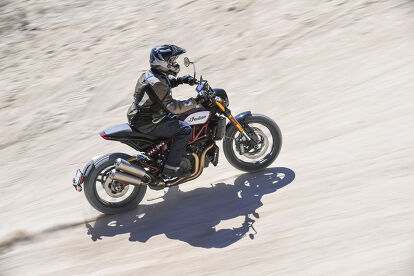
Helmet: HJC DS-X1 $153 to $162
- Jacket: Spidi Hard Track D124/A Discontinued
- Pants: Reax 215 $169
- Gloves: Reax Superfly Mesh $69
Boots: Sidi Canyon Gore-Tex $350
2019 Indian FTR1200 Specifications | |
|---|---|
| MSRP | Thunder Black Base, $13,499 Red over Steel Gray, Titanium Metallic over Thunder Black Pearl $15,499 Race Replica, $16,999 |
| Engine Type | 1203 cc liquid-cooled 60-degree V-twin, DOHC, four valves per cylinder |
| Bore and Stroke | 102 x 73.6mm |
| Compression Ratio | 12.5:1 |
| Rear Wheel Horsepower | 123 hp at 8250 rpm (claimed) |
| Torque | 87 lb-ft at 6000 rpm (claimed) |
| Transmission | 6-speed, slip/assist clutch |
| Final Drive | #525 chain |
| Front Suspension | Sachs 43mm inverted cartridge fork; adjustable for spring preload, rebound and compression damping on FTR1200 S, 5.9-in travel |
| Rear Suspension | Sachs single shock; adjustable for spring preload, rebound and compression damping on FTR1200 S; adjustable for spring preload and rebound damping on FTR1200, 5.9-in travel |
| Front Brake | Dual 320mm discs; radial-mount Brembo four-piston calipers, ABS (lean-sensitive on FTR1200 S) |
| Rear Brake | 265mm disc, Brembo 2-piston caliper |
| Front Tire | Dunlop DT3-R 120/70R-19 |
| Rear Tire | Dunlop DT3-R 150/80R-18 |
| Rake/Trail | 26.3° / 5.1 inch |
| Wheelbase | 60.0 inch |
| Seat Height | 31.7 in laden/ 33.1 in unladen |
| Dry weight | 488 lbs (claimed) |
| Fuel Capacity | 3.4 gallons |
| Warranty | 2 Years, unlimited miles |
We are committed to finding, researching, and recommending the best products. We earn commissions from purchases you make using the retail links in our product reviews. Learn more about how this works.
More by John Burns































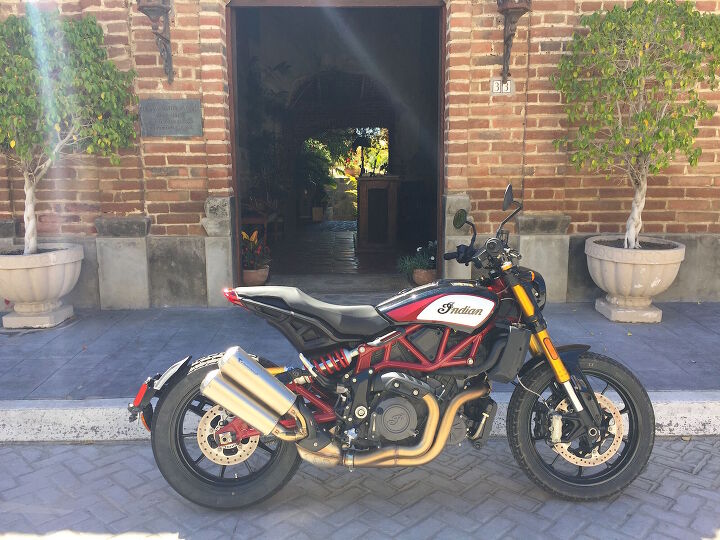























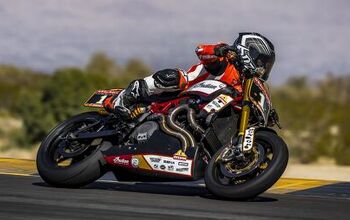




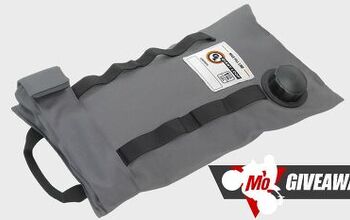








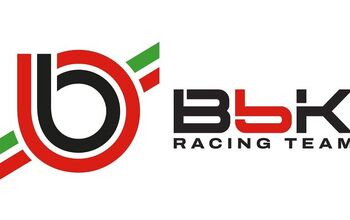

Comments
Join the conversation
Goddamnit, I have to start paying attention to the videos that go with the narrative. You're developing a natural patter, JB. Enjoyed your commentary. Did Sean do the filming, editing, etc.? It has some of the earmarks of his work, and yet I might be persuaded that it's not all him.
Will they use this engine to make a ST? That would be cool.